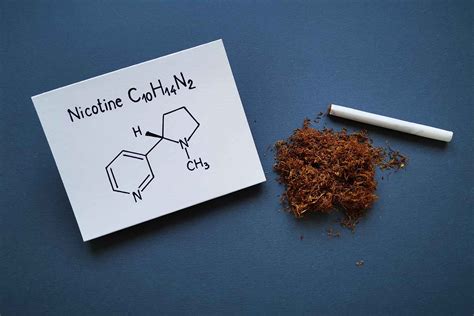Breaking the Chains of Nicotine Addiction: A Comprehensive Guide to Freedom
Nicotine, a highly addictive substance found in tobacco products, wreaks havoc on our physical and mental well-being. Its grip can seem unyielding, but freedom is within reach. This comprehensive guide empowers you with essential knowledge and strategies to break the chains of nicotine addiction.
Understanding Nicotine's Hold
Nicotine acts on the brain's reward pathways, releasing dopamine and creating a sense of pleasure. However, this fleeting high comes at a steep cost, as nicotine use leads to a host of health risks, including increased risk of cancer, heart disease, and respiratory issues.
The Journey to Quitting
Quitting nicotine can be challenging, but with determination and the right support, it is possible.
Withdrawal Symptoms
As the body adjusts to being nicotine-free, withdrawal symptoms can range from intense cravings and irritability to difficulty concentrating and sleeping disturbances. These symptoms typically subside within a few weeks, although some may experience lingering effects.

Triggers and Temptation
Identifying and avoiding triggers that prompt nicotine cravings is crucial. These triggers can include stress, certain social situations, or even the sight or smell of tobacco. It's essential to develop coping mechanisms to resist temptation.

Effective Strategies
Gradual Reduction
Gradually reducing nicotine intake over time can help minimize withdrawal symptoms. This approach involves using lower nicotine-content products, such as patches or gum, and gradually weaning down.

Cold Turkey
Quitting abruptly without any nicotine replacement can be effective for some people. However, it's important to be aware of the potential for more severe withdrawal symptoms.
Nicotine Replacement Therapy (NRT)
NRT involves using products such as patches, gum, or lozenges that deliver small amounts of nicotine to help reduce cravings and withdrawal symptoms.
Medication
Prescribed medications, such as varenicline or bupropion, can help reduce nicotine cravings and withdrawal symptoms.

Behavioral Therapy
Cognitive behavioral therapy (CBT) can help individuals develop coping mechanisms, challenge negative thoughts, and prevent relapse.
Common Mistakes to Avoid
Underestimating the Addiction
Failing to recognize the power of nicotine addiction can lead to setbacks. It's crucial to approach quitting with a realistic understanding of the challenges involved.
Setting Unrealistic Goals
Quitting "cold turkey" or setting unrealistic timelines can lead to disappointment and relapse. Gradual reduction or NRT may be more successful.
Lack of Support
Quitting nicotine is easier with the support of family, friends, or a support group. Isolating yourself can increase the risk of relapse.
Why Quitting Nicotine Matters
Health Benefits
Quitting nicotine significantly reduces the risk of cancer, heart disease, and respiratory issues. It also improves lung function and overall well-being.
Financial Benefits
Tobacco products are expensive. Quitting can save you money and free up resources for more fulfilling pursuits.
Social Benefits
Quitting nicotine can improve relationships and enhance social interactions. Non-smokers often feel more comfortable around those who don't smoke.
Psychological Benefits
Quitting nicotine can boost mood, reduce stress, and improve cognitive function. It can also increase self-esteem and confidence.
Advanced Features
Vaping
E-cigarettes deliver nicotine through vapor. While vaping may be less harmful than traditional tobacco products, it's not without risks and should not be used as a long-term nicotine replacement.
Nicotine Pouches
Nicotine pouches are small, teabag-like products that deliver nicotine through the gums. They are a discreet alternative to traditional tobacco products and may offer potential harm reduction.
Potential Drawbacks
Relapse
Relapse is a common part of the quitting process. It's important not to give up on quitting and seek support if needed.
Side Effects of NRT
NRT products can cause side effects such as nausea, dizziness, or headaches. Most side effects are mild and temporary.
Long-Term Health Effects
While quitting nicotine significantly reduces health risks, some long-term effects of smoking may persist, such as increased risk of chronic obstructive pulmonary disease (COPD).
Call to Action
Quitting nicotine is an investment in your health and well-being. By understanding the challenges, developing effective strategies, and seeking support when needed, you can break the chains of addiction and reclaim your freedom.
Additional Resources:
Humorous Stories and Lessons Learned
1. The "Smoked a Hole in My Shirt" Incident
One person, eager to quit nicotine, abruptly decided to go cold turkey. However, the cravings were so intense that they lit up a cigarette in secret, only to burn a hole in their shirt while trying to hide it. The embarrassing incident served as a reminder that quitting requires more than just willpower.
2. The "Nicotine Gum Disguise" Attempt
Another individual, desperate to avoid cravings at a social event, tried to discreetly chew nicotine gum while pretending to eat a mint. Unfortunately, the gum stuck to their teeth, creating a noticeable bulge that made their teeth appear abnormally large. The lesson here is that it's best to be honest about your quitting journey and seek support instead of resorting to silly disguises.
3. The "Nicotine Withdrawal and the Alien Spacecraft"
During a bout of nicotine withdrawal, one person experienced intense shaking and tremors. Their spouse, alarmed by the strange behavior, called 911, fearing their partner had been abducted by aliens. After paramedics arrived and administered some caffeine, the person realized that the tremors were simply a side effect of nicotine withdrawal. This humorous incident highlights the importance of recognizing and understanding withdrawal symptoms.
Table 1: Health Risks of Smoking
| Health Risk |
Relative Risk |
| Lung cancer |
20x |
| Heart disease |
2x |
| Stroke |
4x |
| Respiratory issues |
10x |
Table 2: Quitting Smoking Success Rates
| Method |
Success Rate |
| Cold turkey |
3-10% |
| Gradual reduction |
15-25% |
| Nicotine replacement therapy (NRT) |
25-40% |
| Medication |
35-50% |
| Behavioral therapy |
40-60% |
Table 3: Benefits of Quitting Smoking
| Benefit |
Timeframe |
| Reduced risk of lung cancer |
5-10 years |
| Improved lung function |
1-2 years |
| Reduced risk of heart disease |
2-5 years |
| Enhanced social interactions |
Immediate |
| Increased self-esteem |
Gradual |
